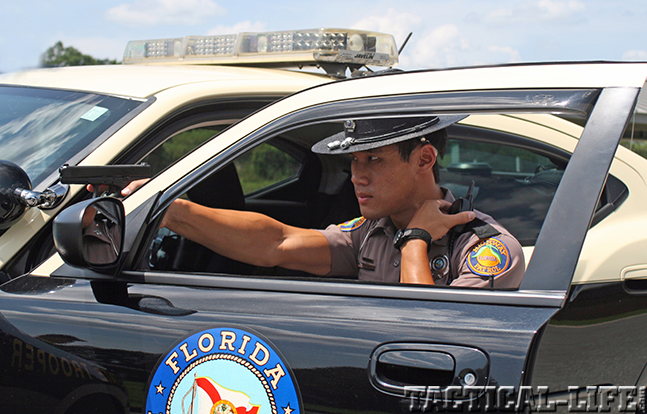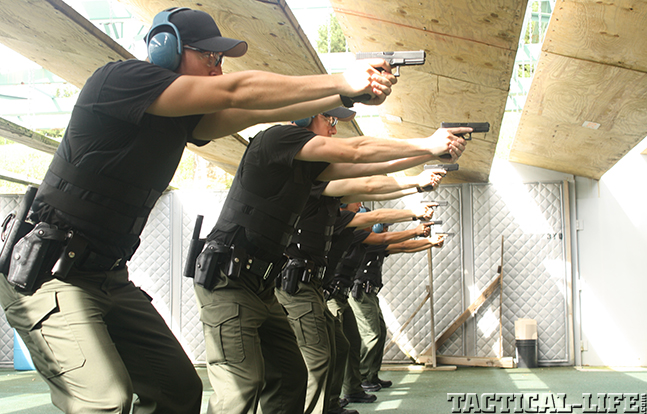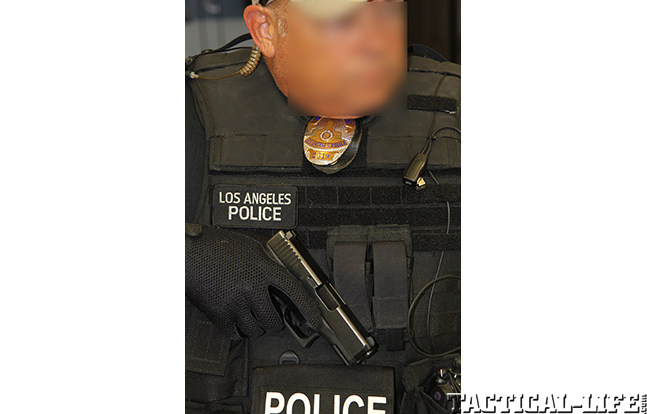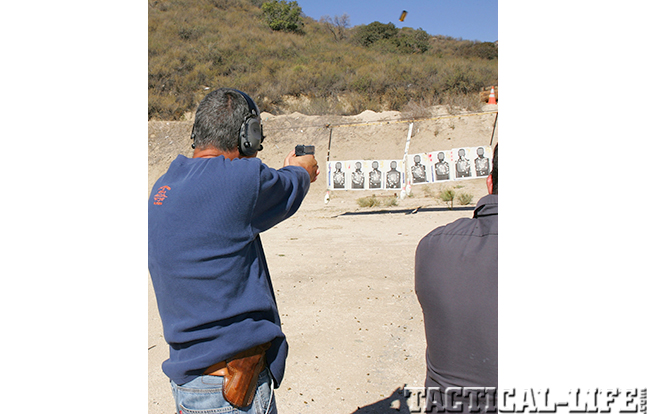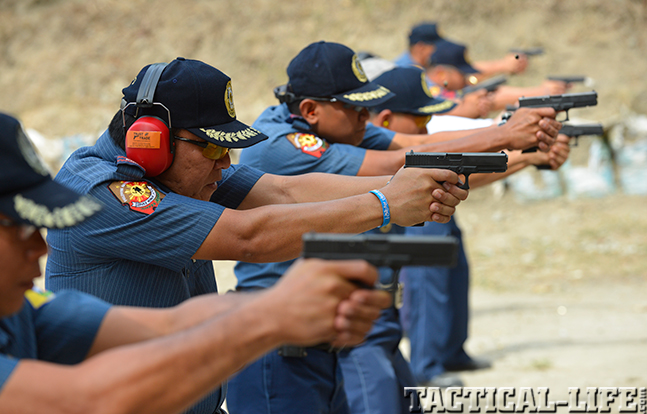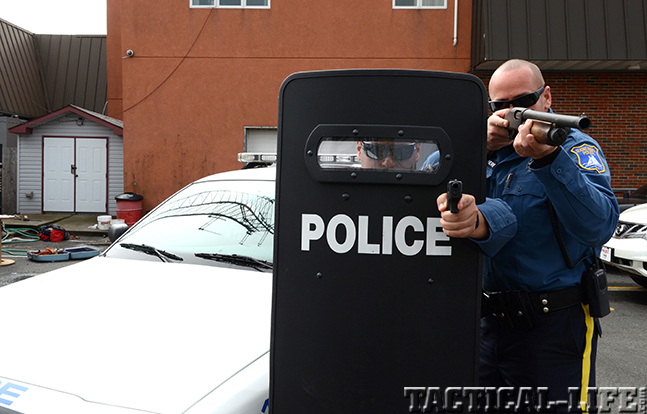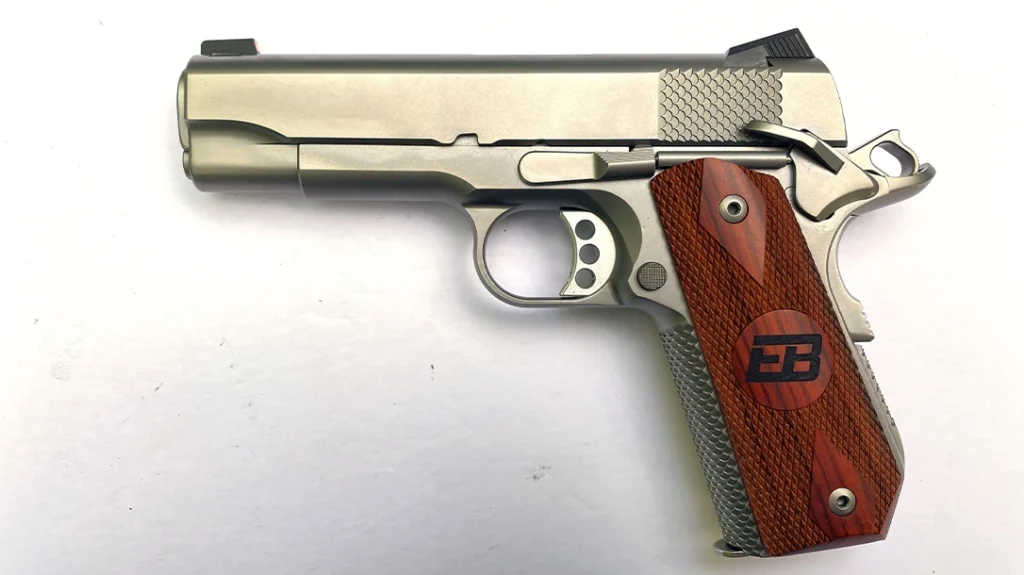Glocks are by a wide margin the most commonly used sidearm in American law enforcement, filling the holsters of more than 65 percent of the nation’s cops.
It’s not hard to see why: Simply designed, they’re simple to use and relatively easy to master; and, with fewer parts, they’re easier and cheaper to maintain. Featuring (in their Gen4 iterations) interchangeable backstraps, they fit multiple hand sizes, allowing for wide departmental use. They’re accurate, and they’re high capacity, with all but a few Glock compacts holding 10 or more rounds of 9mm, .40 or .45 ACP ammunition.
Thanks to its Safe Action trigger system, a Glock is both highly safe (never firing if dropped) and, with no external safety to disengage, quick to bring into action. Lastly, but hardly least, they’re famously rugged and reliable. When called upon, they work, and work well. For the officer who finds him or herself in a life-or-death situation, a dependably functioning firearm is a tool of obvious, inestimable value.
Advertisement — Continue Reading Below
Glocks dominate the law enforcement landscape, but sales have by no means peaked. Every year, non-Glock agencies make the switch, recognizing what so many departments long ago discovered—that Glocks are far and away the best sidearm suited to serious police work. In the following pages, we take a look at eight recent LE converts, crisscrossing the country, and the seas, to uncover PDs both large and small that, having evaluated their needs and weighed their options, took the step trodden by so many brother agencies the world over: They opted to go Glock.
Atlanta, Ga., PD
Advertisement — Continue Reading Below
Glock’s North American headquarters are located in Smyrna, Georgia. Roughly 15 miles away is Atlanta, the country’s ninth-largest metropolitan area. As befits a large, modern city, Atlanta has a sizable police department, with nearly 2,000 sworn personnel assigned to a wide variety of units, from uniformed patrol to SWAT to K-9. In 2013, the Atlanta Police Department (APD), looking to upgrade on its standard-issue sidearm, made the call to Smyrna and requested a set of Glock 22 Gen4 pistols for testing and evaluation. After conducting a very rigorous, 6,000-round torture test, which the G22s aced flawlessly, the APD “pulled the trigger,” so to speak, placing the largest U.S. departmental order yet seen for a Glock Gen4 pistol.
Why the G22 Gen4? With its 15+1 capacity, Safe Action trigger, 360-degree grip texturing, interchangeable backstraps, dual-recoil-spring assembly for reduced recoil and hard-hitting .40-caliber payload, the G22 Gen4 is accurate, controllable and powerful—a serious, big-bore sidearm that’s also easy to use and master. According to APD firearms instructor Sgt. M. Banja, “The [G22 Gen4] performed significantly better in the hands of a poorer shooter” than the duty sidearm it replaced.
The G22 isn’t the only Glock autopistol the APD is purchasing. To the department’s SWAT team will go the Glock 21 Gen4 in .45 ACP, while a cache of compact Glock 26 Gen4s is being reserved for officers on special assignment.
Advertisement — Continue Reading Below
For more, check out Chris Edwards’ extensive report on the APD’s historic shift, published in the 2014 issue of GLOCK Autopistols or visit PersonalDefenseWorld.com.
Chesterfield, Va., PD
“You know you must be doing something right when the bad guys go out of their way to avoid your jurisdiction,” writes Jorge Amselle in the 2013 issue of GLOCK Autopistols magazine. “The Chesterfield County Police Department, stationed just outside of Richmond, Va., has developed a reputation for cracking down on crime. The combination of strict enforcement, top-notch training, improved gear and equipment, and tough judges that hand down equally tough sentences has earned the county the nickname of “Arresterfield” among the area’s criminals. In fact, the old jailhouse still retains the wooden stockade on its front porch and is conveniently located within sight of the new jail.”
Advertisement — Continue Reading Below
In 2007, to make the department all the more formidable, the Chesterfield PD conducted a search for a new, better service handgun. A committee was formed, and eight different pistols were brought forward for consideration. Attention was paid to reputation, reliability, and ease of training and maintenance. Eventually, the committee narrowed its choices to two, one of which was the Glock 22 Gen4 in .40. The guns were test-fired extensively by training officers, and the G22 Gen4 was proclaimed the winner. According to Chesterfield Training Officer/Range Master Carlos Gibson, the G22 Gen4’s consistent trigger pull greatly aided in training officers, as did its simple disassembly process.
To learn more about the Chesterfield County PD, its duties and its transition to the G22 Gen4, pick up a copy of GLOCK Autopistols 2013 or visit PersonalDefenseWorld.com.
Cramerton, N.C., PD
Advertisement — Continue Reading Below
“Cramerton is a small town located in Gaston County, North Carolina, a 25-minute drive from Charlotte,” writes Andre’ Dall’au in the 2014 issue of GLOCK Autopistols. “It is an all-American town, where kids roller–skate on the sidewalks, nightly movies play on the town green (bring your own lawn chairs and blankets) and bible verses are displayed on Main Street marquees. The town is named after Stuart Warren Cramer, who owned a cotton-spinning mill located along the banks of the South Fork River. In an attempt to regulate factory temperature and humidity, and remove lint from the air (a persistent problem in textile mills), Cramer, a mill designer of genius, patented the ‘Cramer System of Air Conditioning,’ from which the modern-day term ‘air conditioning’ is derived.
“In a town renowned for its history-making engineering, it’s fitting that its police, the Cramerton Police Department and the Special Operations Response Team (SORT), recently decided to adopt the latest development in firearms technology, the Glock 22 Gen4. Although a small police department, the Cramerton PD understands the threats both criminal and terroristic posed to the communities of Cramerton and nearby McAdenville (also known as ‘Christmastown USA’ for its extensive holiday lighting displays.) Working under the guidance of their chief, Greg Ratchford, all Cramerton sworn officers are trained in special-operations tactics, which are reinforced by frequent range instruction from in-house and guest instructors. Chief Ratchford demands the best of his officers, and to be at their best, they need best equipment. To that end, the department has opted to issue to its troopers the best possible sidearm, the .40-caliber G22 Gen4.”
To learn more about Cramerton’s switch to the G22 Gen4, pick up a hard copy of GLOCK Autopistols 2014 or visit PersonalDefenseWorld.com.
Advertisement — Continue Reading Below
Florida Highway Patrol
In 2011, Massad Ayoob traveled to Florida to interview some of the men and women responsible for the Florida Highway Patrol (FHP)’s adaptation of the Glock 37 and Glock 39 in .45 G.A.P. According to Ayoob, the FHP was the fifth state law enforcement agency in the nation to adopt the .45 G.A.P. cartridge. The transition, which began in second quarter 2010, was the culmination of sixteen months of study and planning.
As Ayoob reports, “The test committee members ranged in rank from civilian armorer to captain and included many troopers, but each had an equal voice. Trooper Melissa Oman, statewide firearms coordinator for the FHP, was careful to assemble a group that included not only instructors and master shooters, but also shooters who had experienced problems mastering the handgun over the years. ‘We weren’t selecting a pistol for the gun gurus,’ Oman told GLOCK Autopistols. ‘From the beginning, it was clear to all that we were picking a gun for every sworn member of the Florida Highway Patrol. Ability with the service pistol can be the difference between life and death for any of our people on any given day.’”
Advertisement — Continue Reading Below
Over the course of the study period, “the pendulum slowly but surely swung toward the G.A.P. The impressive performance of the newer round was certainly one reason. But so was the fact that in side-by-side testing, most of the troopers felt the G37 was more controllable. Being slightly smaller, it allowed ‘more hand to get around the gun,’ and its bore axis was very slightly lower, an advantage in controlling muzzle jump. Early in 2010, the FHP study group received the first prototypes of the G37 Gen4, which brought the members still more toward the G.A.P. side. The new-style pistol has an even smaller grip girth and shorter trigger reach, suiting it better for small hands, but it still has two backstrap adjustment pieces that can be fitted to tailor the gun to larger hands and longer fingers. Also, the Gen4 comes with RTF (Rough Textured Finish) treatment, which allows better grasp with less slippage.”
As Ayoob note, response from the rank and file was extremely positive. “As the committee expected, some of the most enthusiastic are those who previously were the weakest shooters. They now have a pistol that better fits their hands, a pistol they can control better. In one transition class, a trooper who had often struggled to qualify easily passed the course on the first try with the new GLOCK. Many troopers have reported that the .45 G.A.P. feels to them as if it ‘kicks less’ than the snappy .40 round (a 180-grain subsonic) that they had carried until now.”
To learn more about the FHP’s switch to the G37 Gen4 and the G39, pick up a hard copy of GLOCK Autopistols 2011 or visit PersonalDefenseWorld.com.
Advertisement — Continue Reading Below
Los Angeles, Calif., PD SIS
Police departments aren’t often at the forefront of cutting-edge weapons design. But then, the super-secret Special Investigation Services, the surveillance and intelligence-gathering arm of the LAPD, isn’t your ordinary unit. Created in 1965 to solve cases the other detective units couldn’t, the SIS has tangled with some of the most dangerous offenders in the country, including terrorists, bank robbers, serial killers and drug kingpins. A specialty of the SIS is the “Hot Take Down,” when the surveilling officers don their tactical vests and interdict suspects as they exit the scene of the crime. The result is frequently a firefight—in-transit criminals rarely come in quietly. The SIS beat is a dangerous one, mixing absolute discretion on the one hand, and tactical derring-do on the other. On the job, SIS agents need a backup sidearm as multifaceted as they, slim and compact for all-day concealment, yet powerful and capacious enough to win a fight against a deadly, determined foe.
In 2011, the SIS, having evaluated its needs and reviewed the existing options, queried Glock, tasking the company to build a slim, light autopistol, chambered in .45 ACP, that could accommodate the unit’s 13-round Glock 21 magazines. As GLOCK Autopistols 2014 correspondent John Fasano reports, “GLOCK’s legendary factory engineers took the challenge in stride.
“They started by taking the already slim body of the G30SF and shaving down the mass and height of the slide to match the dimensions of the slide on the G36. It was more than a matter of simply slapping a G36 slide onto a G30 body. Lightened, it had to work reliably with the LAPD’s heavy 230-grain duty loads, and that meant creating a new balance of weight and springs.
“Through its Austrian alchemy, Glock created a new pistol that brought the total weight of the new, fully loaded G30S down to just 30.16 ounces. With an overall length equal to the G30’s at just under 7 inches, the G30S’s 3.78-inch-long, 1-in-15-inch-twist barrel sits closer to the shooter’s hand and has octagonal rifling for a better gas seal and increased performance. The LE-authorized Safe Action trigger breaks at 5.5 pounds, and the new pistol, named the Glock 30S (“S” for Slim) is supplied to the SIS with both a flat-bottom magazine that holds nine rounds for main concealed carry and a finger-rest magazine that holds 10.”
The new pistol was a hit, and not just with the SIS. Made available to civilians in 2013, the G30S is one of Glock’s best-selling pistols.
To read the entirety of its remarkable creation story, pick up a copy of GLOCK Autopistols 2014 or visit PersonalDefenseWorld.com.
Philippine National Police
The histories of the Philippines and the United States have long been interlinked; and one, less-often-noted legacy of the two countries’ century-plus-long relationship is the similarity of their firearms laws and culture. Many Filipinos, like many Americans, are avid gun owners and shooters, with a shared taste for full-size, powerful, no-nonsense handguns. Unsurprisingly, in both countries Glocks are popular, and not only among civilians. In 2013, the Philippine National Police took a page from the American law enforcement playbook, and made the single largest firearms order in the history of Glock, Inc., requesting the shipment of over 74,000 GLOCK 17 Gen4 autopistols to be distributed among the agency’s 146,000 officers.
In the 2014 issue of GLOCK Autopistols, Andre’ Dall’au tells the tale: “the PNP is comprised of over 146,000 personnel, but only about half of them have issued sidearms. In an attempt arm all of their federal law enforcement officers with the best pistol possible, the government of the Philippines devised an evaluation program based on a series of transparent and logical tests to determine the cost-effectiveness, reliability and ruggedness of each prospect.
“The first stage of testing determined the optimal cost of purchasing and maintaining each pistol. It involved a review of the firearm’s worldwide performance with other law enforcement agencies, as well as an honest evaluation of the manufacturer’s ability to produce and deliver the desired sidearm for the contract price. That done, the process accelerated to the second stage, in which the firearm was physically tested.
“The second stage included accuracy, magnetic particle, steel composition and ‘torture’ testing. Over a four-day period, testers fired 5,000 rounds of 9×19 ammunition per day from a single test handgun, shooting 20,000 rounds in total. To put that into perspective, 20,000 rounds over four days comes to an average of seven rounds fired per minute for 12 hours. Or, put another way, one round was shot successfully every 9 seconds, from 6 a.m. to 6 p.m., for four consecutive days!”
As it so often is, Glock was declared the winner. Writes Dall’au, “When people decide to buy a handgun, they typically base their decision on a given gun’s mix of cost-effectiveness, accuracy, reliability and ease of maintenance. The PNP [did] just that, seeking to give its sworn officers unrivaled personal protection while also receiving from the chosen manufacturer excellent value. Like a savvy shopper at a gun shop, the PNP demonstrated exceptional foresight, fiscal responsibility and an acute understanding of what it is that makes a gun useable, accurate and reliable. Naturally, they chose Glock—or, more precisely, they chose nearly 75,000 Glocks—building a national arsenal guaranteed to keep its officers and citizens safe for many years to come.”
To read more about the PNP’s historic transition, pick up a hard copy of GLOCK Autopistols 2014.
Seaside Heights, N.J., PD
For about nine months a year, Seaside Heights, N.J., is a sleepy, quiet, 3,000-person burg. For the remaining three—June, July and August—it’s a frenzied, bacchanalian, nationally known tourist spot, immortalized on the silver screen via the late, lamented MTV hit Jersey Shore. A lot of what goes on in Seaside Heights is family friendly, but non-trivial percentage of the fun is not—and some of it is downright criminal, with the city’s hard-partying, young-adult demographic being an attractive target for drug dealers, and a not-infrequent source of alcohol-fueled melees and fisticuffs. Says Seaside Heights Police Chief Tommy Boyd, a Seaside native and 28-year veteran of the force, “During the four days of Memorial Day weekend, we will average around 400 arrests, or 100 arrests per day, with charges ranging from aggravated assault to drunk and disorderly conduct. The summer is always a busy time for us.”
To better keep the peace, the Seaside Heights PD recently purchased 58 Glock 27s in .40. “My department has 43 full-time police officers that work year-round,” Boyd says, “On average, the department handles about 2,600 in custody arrests per year and thousands of calls for assistance. Despite the size, we are a very busy department.”
To take an extended ride-along with the G27-carrying Seaside Heights PD, pick up a hard copy of the 2013 issue of GLOCK Autopistols or visit PersonalDefenseWorld.com.
Tacoma, Wash., PD
“For 10 years,” Mark Kakkuri writes in the 2013 issue of GLOCK Autopistols, “the police department of Tacoma, Wash., offered its officers two duty handgun choices: a 1911 or Glock.” In 2013, however, the department decided to only offer Glocks. Traveling to Tacoma, Kakkuri sat down with range sergeant James Barrett to discuss the nuances of the department’s decision.
“For the duty handguns,” Barrett told Kakkuri, “the Tacoma PD evaluated several firearm makes and models to replace our aging 1911s and Glocks. We had been giving officers a choice between the G21, G22 and G23 and variations of the 1911. We’ve since decided to go all-Glock, and officers can choose between several Glock models: the G17, G19, G21, G22, G23 or G30. All of these are Gen4 models. Our department ordered 458 various numbers of these models and we look forward to accepting them. We plan to transition all officers to the new handguns between January and June 2013. By the end of that period, all department members will be issued a new Gen4 Glock.
“All factors were considered,” Barrett continued, “including ease of use, cleaning and maintenance, officer choice and familiarity, customer service from the manufacturer, previous Tacoma PD experience, other regional agency experience and cost. We also considered adding the 9×19 caliber for our officers in addition to the already approved .40 and .45 AUTO.
“The bottom line,” Barrett said, “current handguns, like any tool that is used over a period of time, are reaching their useful life cycles in terms of reliability. We don’t want even one to fail when it is needed the most. After careful consideration of all of the factors, the department selected the GLOCK Gen4 as the handgun that would best serve the needs of our officers for the next 10 years or so.”
To read more about the Tacoma’s PD decision to go entirely Glock, pick up a copy of GLOCK Autopistols 2013 or visit PersonalDefenseWorld.com.
